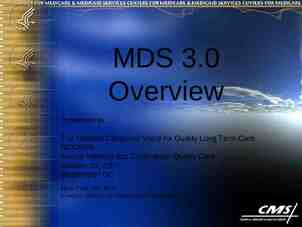Investment Management and Asset Performance in the State Services:
15 Slides1.87 MB
Investment Management and Asset Performance in the State Services: Update Presentation to Investment & Asset Management workshop Victoria University Campus, 11 November 2015
Outline of presentation Coverage Page Investment Management System 3 Change programme 2015-17 4 Developments since July 2015 6 Investor Confidence Rating ( ICR) 7 Long term Investment Plans 10 Update on BBC changes 12
Investment Management System Plan Do Review 10 year (capital intentions) Strategic aims 4 year (SOI & budget plans) 2 year (BBC) Post project Current (approved/ underway) projects and programmes Decision point Constraints Benefits Assets Public value Outcome Intent Think
Change Programme 2015-17 Improved leadership and co-ordination Eg Investment Ministers, Extending the coverage to selected Crown companies More flexible business case frameworks Moving to a more integrated and flexible assurance system Giving greater prominence to longterm investment Introducing a strategic stage gate (SAR or strategic assessment review) Including functional leaders roles and services Implementing portfolio management Reporting on asset and investment performance (benefits, delivery) Introducing an investor confidence rating (ICR) Intent Plan Do Review 10 year (capital intentions) Strategic aims 4 year (SOI & budget plans) 2 year (BBC) Post project Current (approved/ underway) projects and programmes Decision point Constraints Benefits Assets Public value Outcome Introducing capability and performance assessments Think
Focus on 24 Investment-intensive agencies Tranche 1 (2015) Tranche 2 (Feb-June 2016) Tranche 3 (August – December 2016) ACC Corrections Education IRD NZDF NZTA Auckland DHB Northland DHB Counties-Manukau DHB Waitemata DHB Canterbury DHB Conservation Customs Housing NZ Internal Affairs Justice MBIE MFAT MSD Police MoH Waikato DHB Capital and Coast DHB Southern DHB
Recent developments (since July 2015) New expectations published on-line via new Cabinet Office circular CO(15)5 which: Defines what’s in scope of the investment management system Sets out objectives of the investment management system Explains the roles of parties in the system especially the role of Investment Ministers and the Corporate Centre Introduces new incentives regime “Investor Confidence Rating” Places greater focus on long term investment plans as key aspect of the system Confirms the requirements for business cases, project assurance and benefits reporting New Treasury investment management website: http://www.treasury.govt.nz/statesector/investmentmanagement Rolling out ICR across 6 tranche 1 agencies
Investor Confidence Rating ICR being rolled out in 3 tranches over 18 months. ICR is a Cabinet-approved rating of an agency based on mix of 4 lead (e.g. maturity, quality of long term plans) and 4 lag indicators (e.g. asset or project performance). An expression of confidence that investors (e.g. the relevant portfolio Minister, or Investment Ministers) should have in government agencies to manage asset portfolios well and successfully deliver promised benefits from investments. ICR may directly impact the level of delegated authority, scrutiny and support an agency has over investments. Focus for performance improvement
The elements of the ICR Agency capability Periodic independent assessments Asset Management Maturity Lead Portfolio, Programme, Project Management (P3M3) Maturity Change Management Maturity Weight 50% Long term investment plans (portfolio lens) Multi-year plans covering investment intentions with performance linked to outcomes Rating for each long term investment plan Lead Investor confidence rating (ICR) Significant investments (project, programme lens) Performance of portfolio over time Significant investments Delivery performance Lag Benefits delivery Application of system expectations Asset performance 50% Level of compliance with system expectations Periodic Corporate Centre assessments Lag 8
Potential implications from ICR Will vary according to investment context in each agency but potentially there will be . More autonomy than present for some agencies, and Less autonomy than present for others 9
Long-term Investment Plans Describe the investment journey over at least 10 years for an investment-intensive agency The LTIP reveals what will be invested in and how investment will occur in order to support delivery of the agency or sector strategic intentions. The LTIP should be one element of the agency’s overall planning, management and reporting activity. The quality of the LTIP matters: it affects the agency ICR, informs all-of-government portfolio management choices.
Context for Long Term Investment Plans
Better Business Cases - Update BBC has been in place since 2010 to enable smart investment decisions for public value BBC is based on the 5 Case model: Strategic case Economic case Commercial case Financial case Management case Review undertaken earlier this year including expert evaluation, Gateway lessons learned and user feedback New features effective 30 September 2015
BBC – Insights from various sources Expert evaluation Significant improvement in quality of business cases since 2013: Overall level of business case maturity is moderate Business cases being applied well to projects but more emphasis needed on programmes Users Concerned about fit with policy decisions, annual budget process Gateway Lessons Learned report Still significant uncertainty about: the application of the business case framework to programmes; how the process, information can be scaled to the investment context
BBC – New emphasis, features Encourage agencies to use Endorsed BBC Experts Launch Clinics for Investment Intensive Agencies Start publishing BBC case studies Encourage agencies to make use of training Enhance the BBC Reviewers Course for the Corporate Centre Introduce Investment Management Course and Executive sessions Release revised guidance
BBC – Latest guidance http://www.treasury.govt.nz/statesector/investmentmanagement/plan/bbc Clarifies: what’s expected and the suggested evidence the relationship with strategy and policy fit with decisions in annual budget process Introduces: principles-based approach to use of methods and tools different ways of designing and delivering ICT projects recent changes to the Government Procurements Branch’s guidance, early market engagement Replaces: multiple scoping documents into one point of entry document




















